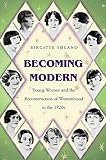Becoming Modern : Young Women and the Reconstruction of Womanhood in the 1920s / Birgitte Søland.
Material type: TextPublisher: Princeton, NJ : Princeton University Press, [2022]Copyright date: ©2001Description: 1 online resource (264 p.) : 20 halftonesContent type:
TextPublisher: Princeton, NJ : Princeton University Press, [2022]Copyright date: ©2001Description: 1 online resource (264 p.) : 20 halftonesContent type: - 9781400839278
- Feminism -- Denmark -- History -- 20th century
- Feminism -- Denmark -- 20th century
- Sex role -- Denmark -- History -- 20th century
- Sex role -- Denmark -- 20th century
- Women -- Denmark -- History -- 20th century
- Women -- Denmark -- 20th century
- SOCIAL SCIENCE / Women's Studies
- Appelgaard, Magda
- Asby, Elna
- Bang-Pedersen, Mathilde
- Bentzen, Viggo
- Brooks, Louise
- Bønnelycke, Emil
- Christensen, Amanda
- Ege, Louise
- Enevold, Lily
- Eriksen, Anna
- Ingvardsen, Dora
- Jensen, Edith
- Jensen, Margrethe
- Johansen, Emilie
- Kristensen, Ingrid
- Kruse, Vinding
- Langelinie Affair
- Lundgaard, Agnes
- Mangart, Inger
- Nedergaard, Henny
- Nielsen, Netta
- Nordic Commission on Family Law
- Nybrandt, Gerda
- Okkels, Jenny
- Petersen, Stine
- Pickford, Mary
- Rerup, Ingeborg
- Reumert, Ellen
- Sommersted, Hedvig
- Sorensen, Nikoline
- Stopes, Marie
- Suhr, Inga
- Swanson, Gloria
- Viby, Marguerite
- Warming, Jens
- advice columns
- birth control
- chivalry
- consumer culture
- courtship
- dancing
- divorce: popular perceptions of
- female friendships
- feminism
- gender antagonism
- hairdressers
- marriage reform legislation
- mother-daughter relationships
- personal narratives
- public entertainment
- wedding vows
- HQ1672
- online - DeGruyter
| Item type | Current library | Call number | URL | Status | Notes | Barcode | |
|---|---|---|---|---|---|---|---|
 eBook
eBook
|
Biblioteca "Angelicum" Pont. Univ. S.Tommaso d'Aquino Nuvola online | online - DeGruyter (Browse shelf(Opens below)) | Online access | Not for loan (Accesso limitato) | Accesso per gli utenti autorizzati / Access for authorized users | (dgr)9781400839278 |
Frontmatter -- Contents -- Acknowledgments -- INTRODUCTION -- PART I From Victorian Ladies to Modern Girls: The Construction of a New Style of Femininity -- CHAPTER 1 The Emergence of the Modern Look -- CHAPTER 2 Fit for Modernity -- PART II The Hew Eve and the Old Adam? The Creation of Modern Gender Relations -- CHAPTER 3 Good Girls and Bad Girls -- CHAPTER 4 Beauties and Boyfriends, Bitches and Brutes -- PART III "A Great Mew Task": The Modernization of Marriage and Domestic Life -- CHAPTER 5 From Pragmatic Unions to Romantic Partnerships? -- CHAPTER 6 "A Most Important Profession" -- CONCLUSION -- Notes -- Select Bibliography -- Index
restricted access online access with authorization star
http://purl.org/coar/access_right/c_16ec
In the decade following World War I, nineteenth-century womanhood came under attack not only from feminists but also from innumerable "ordinary" young women determined to create "modern" lives for themselves. These young women cut their hair, wore short skirts, worked for wages, sought entertainment outside the home, and developed new attitudes toward domesticity, sexuality, and their bodies. Historians have generally located the origins of this shift in women's lives in the upheavals of World War I. Birgitte Søland's exquisite social and cultural history suggests, however, that they are to be found not in the war itself, but in much broader social and economic changes.Søland's engrossing chronicle draws on a rich variety of sources--including popular media and medical works as well as archival records and oral histories--to examine how notions of femininity and womanhood were reshaped in Denmark, a small, largely agrarian country that remained neutral during the war. It explores changes in the female body and personality, the forays of young women into the public sphere, the redefinition of female respectability, and new understandings of married life as evidenced in both cultural discourses and social practices. Though specific in its focus, the book raises broad comparative questions as it challenges common assumptions about the social and sexual upheavals that characterized the Western world in the postwar decade. In a remarkably engaging fashion, it shows why the end of World War I did not lead to the return of "normal" life in the 1920s.
Mode of access: Internet via World Wide Web.
In English.
Description based on online resource; title from PDF title page (publisher's Web site, viewed 29. Jul 2022)


